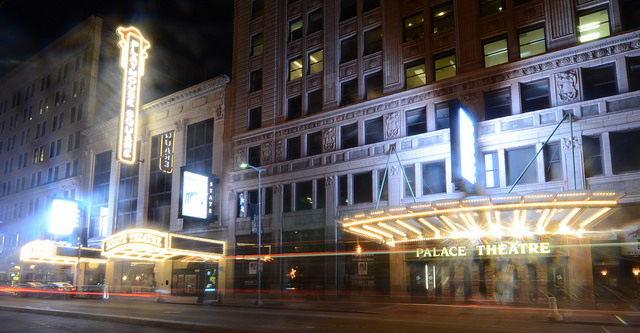
The dramatic PlayhouseSquare at night. Photo © Erik Drost, licensed Creative Commons Attribution.
Like all cities, Cleveland has blown it by demolishing buildings with great architectural merit. Only in hindsight do civic leaders and city residents typically grasp the value of what’s been lost in the name of progress. If not for the work of a few visionary preservationists in the 1970s, Cleveland’s PlayhouseSquare would have vanished like so many other architectural gems. Built in the classical style, the Ohio, State, Palace, Allen, and Hanna Theaters boasted expanses of marble, lush hardwoods, hand-painted murals, and extravagant lobbies.PlayhouseSquare’s five opulent theaters opened between 1921 and 1922. Built in the classical style, the Ohio, State, Palace, Allen, and Hanna Theaters boasted expanses of marble, lush hardwoods, hand-painted murals, and extravagant lobbies. For decades these houses entertained pleasure seekers with a variety of vaudeville acts, cinema, and dramatic performances.In the late 1960s, downtown suffered from a disastrous cocktail of economic distress, suburban flight, and racial disquiet. Shops closed, people fled, and the theaters went dark. Vandals, thieves, and inattention so damaged the shuttered theaters that demolition was all but assured.
Led by Ray Shepardson, a nonprofit called PlayhouseSquare Association campaigned to save the theaters. Thanks to public and private partnerships, money was raised to not only save the buildings from destruction, but also to begin repairing and restoring them. By the late 1990s, four of the five theaters had been restored to their former glory. In 2008, the last of the five reopened as the stunning new home of the Great Lakes Theater Festival. These days, every year more than a million visitors see performances at these venues and scores of smaller performance spaces concentrated in the two-block zone, and the economic overflow can be observed at area restaurants, shops, and hotels.
Walk through PlayhouseSquare on a brisk fall night and it’s easy to see what Shepardson worked so hard to preserve. After all, without the arts, where is the beauty of life?
Excerpted from the Second Edition of Moon Cleveland.